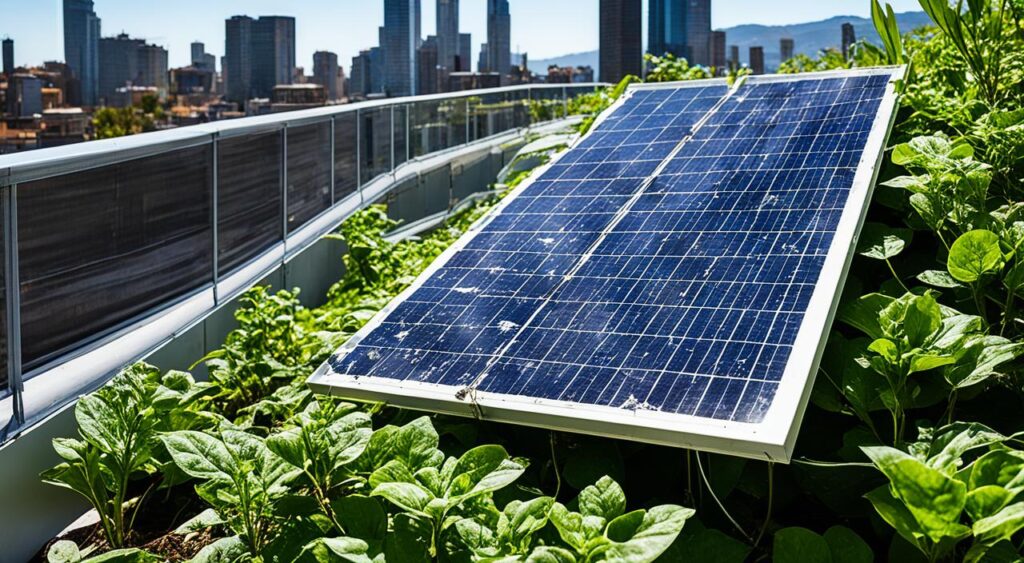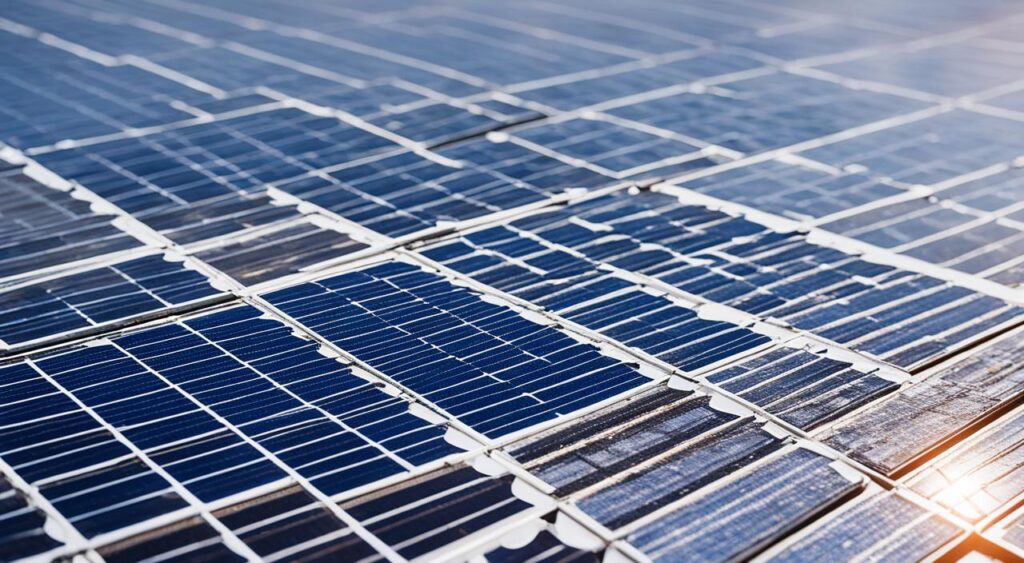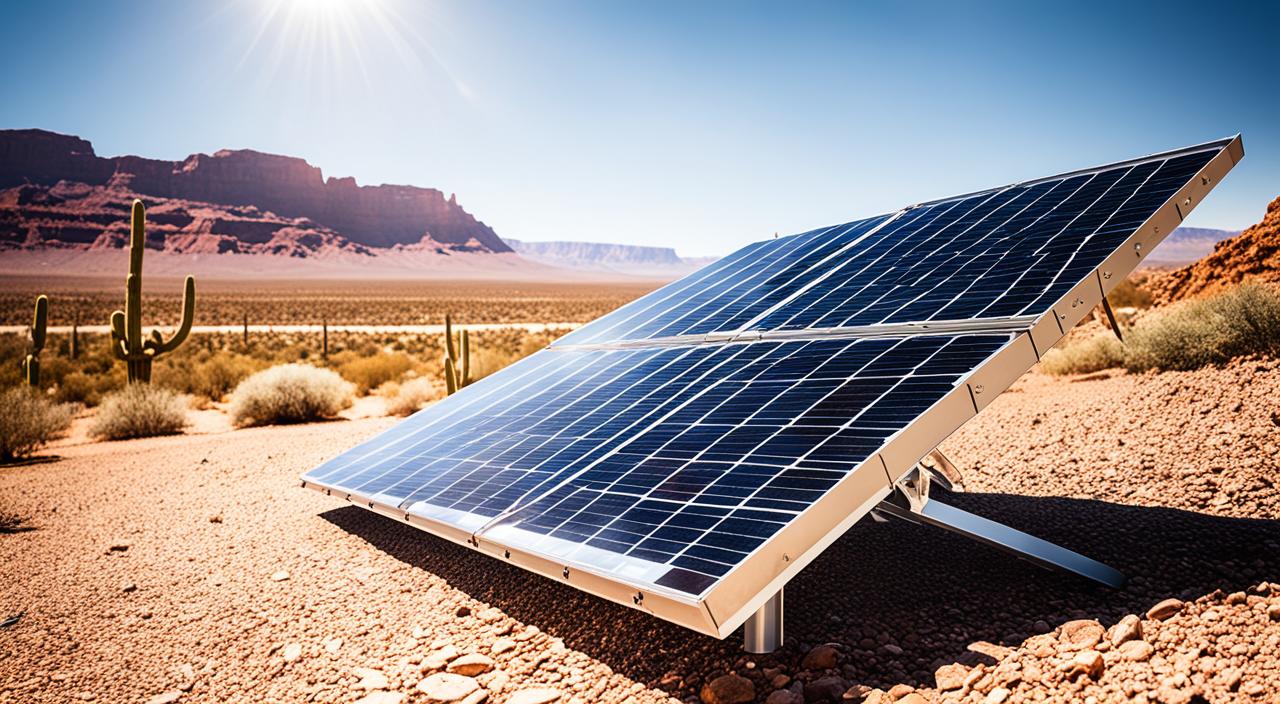Solar Panels Lifespan: How Long Do Solar Panels Last?
More people are looking into renewable energy, making it key to know how long solar panels last. This article will cover the typical life of solar technology and what affects its durability. Knowing this helps you make smart choices when picking a renewable energy system for your place.
We’ll talk about how to keep your solar panels working well and lasting longer. We’ll also look at new trends in this fast-changing field. This is useful for homeowners thinking about solar or businesses wanting to cut down on carbon emissions.
Key Takeaways
- Solar panels usually last 25 to 30 years, with some lasting even longer.
- Things like temperature, humidity, and weather can really affect how long solar panels last.
- Getting your solar panels installed right and keeping them maintained is key to their long life.
- Solar panel warranties and guarantees give you peace of mind and protect your investment.
- New tech like bifacial solar panels and better materials might make solar energy even more reliable and efficient.
Introduction to Solar Panel Lifespan
More people are turning to solar energy, making it key to know how long solar panels last. These panels are a big investment, and their life affects how cost-effective they are over time. We’ll look at how long solar panels usually last and what affects their durability and performance.
Solar panels are built to last, providing power for many years. The solar panel lifetime, or the solar energy system lifespan, is important for anyone thinking about solar power. Knowing how long solar panels last helps people make smart choices and plan for the future.
Factors Affecting Solar Panel Durability
Many things can affect how long solar panels last, like the weather and the materials used to make them. Let’s dive into these factors:
- Environmental Conditions: Things like temperature, humidity, wind, and UV rays can wear down solar panels. Panels in tough climates or polluted areas might not last as long.
- Quality of Materials: Using top-notch materials, like strong solar cells and weatherproof covers, helps panels last longer. Cheap parts can lead to early failures or lower performance.
Knowing these things helps people pick and care for their solar systems better. This way, they can get the most out of their solar panel lifetime and solar energy system lifespan.

Understanding solar panel lifespan and what affects it helps people make better choices. This way, they can enjoy the benefits of clean, renewable energy for a long time.
Factors Affecting Solar Panel Durability
Solar panels last longer when we consider several environmental and design factors. Let’s look at how these elements affect their lifespan.
Environmental Conditions
Where solar panels are placed matters a lot for their life and performance. Things like temperature, humidity, and UV radiation can harm the panels over time.
- High temperatures can make solar panel parts age faster, lowering efficiency and lifespan.
- Humidity and moisture can corrode and damage the inside parts, making panels less reliable.
- UV radiation can break down the protective layers and materials, making panels more prone to damage.
Quality of Materials
The materials used in making solar panels are key to their lifespan. Using high-quality parts and processes makes them last longer and work better.
| Material Quality | Impact on Solar Panel Lifespan |
|---|---|
| Monocrystalline silicon | Increases resistance to wear and keeps efficiency up longer |
| Tempered glass | Protects against damage and weathering |
| Strong frame and mounts | Makes panels more durable and resistant to environmental stress |
Knowing what affects solar panel durability helps owners and installers make better choices. This way, they can make sure these energy systems work well for a long time.

Typical Lifespan of Solar Panels
The average solar panel lifespan is quite impressive. Most solar panels are built to last a long time. They usually come with warranties from 20 to 25 years. But, the actual lifespan can change based on different factors, as we talked about before.
Industry data shows the typical solar panel life expectancy is about 25 to 30 years. This means a well-cared-for solar panel system can keep generating electricity for decades. It offers a steady and green energy source for homes and businesses.
The standard solar panel lifetime depends on the panel’s materials and the environment it faces. Things like temperature, humidity, and exposure to wind, snow, and hail affect its lifespan.
The average solar panel lifespan is not set in stone. It varies based on the panel and its setup. With good maintenance, many solar panels can go beyond their warranty and keep providing power for more years.
| Metric | Range |
|---|---|
| Typical Solar Panel Lifetime | 25 to 30 years |
| Standard Solar Panel Warranty | 20 to 25 years |
| Average Solar Panel Lifespan | 25 to 30 years |
Knowing how long solar panels last helps people make better choices about solar energy. It also helps them plan for the long-term success of their renewable power systems.
How Long Do Solar Panels Last?
Solar panels are known for their long life, making them a great choice for sustainable power. But, their actual solar panel life expectancy depends on several factors. We’ll explore the typical solar panel service life and what affects their solar panel longevity.
Quality solar panels usually last 25 to 30 years. Many come with warranties that promise 80-90% of their original power output for that time. Yet, the actual solar panel life expectancy can change based on the panel’s build, how it’s installed, and its environment.
- Things like extreme weather, humidity, and heavy wind or snow can make solar panels wear out faster.
- The materials and how they’re made also affect how long a solar panel will last.
Getting solar panels installed right and keeping them clean and checked is key to their long life. This helps your solar energy system work better and last longer.
“Solar panels are made to stand up to the weather, but taking good care of them can make them last even longer and work better.”
The average solar panel service life is quite good, but it’s important to watch how they do over time. Knowing what affects their longevity helps you make smart choices for your renewable energy investment. This way, your solar system will keep giving you reliable and efficient power for many years.
Degradation Rates and Performance Over Time
Solar panels are built to last for many years, but they don’t stay at peak performance forever. Over time, they can lose some efficiency. Knowing how fast they degrade helps predict their future performance and when they might need replacing.
Initial Degradation
Right after installation, solar panels might see a small drop in power output. This is called initial degradation. It usually happens as the materials in the solar cells settle down. During this phase, efficiency can drop by 2-3% in the first year.
Long-term Degradation
After the initial drop, solar panels will keep losing efficiency over the years. This loss is about 0.5-0.8% each year. The exact rate can change based on things like solar panel degradation, the environment, and the materials used.
Let’s look at an example to see how degradation affects performance. Say a solar panel starts at 20% efficiency. After 10 years, with a 0.7% yearly loss, it would be down to about 16.5%. This drop in solar panel performance over time can greatly affect how much energy it makes and its cost-effectiveness.
Knowing how solar panel efficiency declines helps owners plan for upkeep, updates, or replacing panels. This way, they can keep their solar investment working well for a long time.
Maximizing Solar Panel Lifespan
Solar panels are made to last and provide power for many years. But, there are steps you can take to make them last even longer. Proper installation and regular maintenance are key to getting the most from your solar energy investment.
Proper Installation
Getting solar panels installed right from the start is vital for their performance and durability. A skilled solar installer will set up your panels at the best angle and position. This ensures they catch the most sunlight and stay safe from the weather. Good installation methods, like secure mounting and weatherproofing, help extend solar panel lifespan.
Regular Maintenance
Keeping up with solar panel maintenance is crucial for their efficiency and long life. This means:
- Cleaning the panels regularly to get rid of dirt, leaves, and bird droppings that block sunlight.
- Checking the panels, wires, and other parts for damage or wear.
- Watching how the system is doing and fixing problems quickly to stop them from getting worse.
By focusing on proper solar panel installation and regular upkeep, you can make your solar system last longer. This way, you can enjoy the perks of renewable energy for years.
| Maintenance Task | Frequency | Benefits |
|---|---|---|
| Panel Cleaning | Quarterly or as needed | Keeps energy production high by removing dirt and debris |
| Visual Inspection | Bi-annually | Finds any damage or wear that needs fixing |
| Performance Monitoring | Continuous | Helps spot problems early and fix them quickly |
Warranties and Guarantees
When you buy a solar energy system, knowing about the warranties and guarantees is key. These promises protect your investment and ensure you’re covered if problems arise. Let’s look at what warranties and guarantees come with solar panels.
Solar Panel Warranty Coverage
Manufacturers offer two main warranties for solar panels: power output warranty and product warranty. The power output warranty promises the panels will keep producing power at a certain level for 20 to 25 years. The product warranty covers defects in materials and workmanship, making sure the panels work right for 10 to 12 years.
Warranty Length and Conditions
Warranty lengths and conditions differ among solar panel manufacturers. Some offer longer warranties or extra coverage for parts like inverters or mounts. It’s important to read the warranty details to know what protection you have. You’ll also need to follow certain rules, like regular upkeep and correct installation, to keep the warranty valid.
| Warranty Type | Average Duration | Key Considerations |
|---|---|---|
| Power Output Warranty | 20-25 years | Guarantees a minimum percentage of the initial power output over the warranty period. |
| Product Warranty | 10-12 years | Covers defects in materials and workmanship, ensuring the panels function as intended. |
Knowing what warranties and guarantees solar panel manufacturers offer helps you make smart choices. It also gives you peace of mind when you invest in solar energy.
Signs of Aging and When to Replace
Solar panels show signs of aging over time, telling us they need replacing or upkeep. Knowing these signs helps homeowners and businesses decide when to update their solar energy systems.
Visual Inspection
Regular checks can show if your solar panels are getting old. Look out for these signs:
- Discoloration or yellowing of the solar cells
- Cracks or chips in the solar panel surface
- Visible damage to the frame or mounting hardware
- Accumulation of debris, dust, or mold on the panel surface
Performance Monitoring
Watching how your solar panels work is also key. Look for these signs to know when to replace them:
- Declining Power Output: A drop in energy production means they’re getting old.
- Increased Maintenance Needs: Cleaning or servicing them more often is a clue they’re not working well.
- Frequent Inverter Errors: Problems with your solar inverter might mean the panels are the issue.
Keep an eye out for these aging signs to keep your solar energy system running well and saving money for a long time.
End-of-Life and Recycling Options
When our solar panels can’t work anymore, we must think about recycling them. Recycling solar panels helps protect the environment and gets valuable materials back into use.
More and more solar panels are ending their life, making disposal a big problem. If not done right, it can harm the environment. New recycling methods and projects are coming up to stop these panels from ending up in landfills. They aim to reuse important parts of the panels.
Solar Panel Recycling
Solar panel recycling is getting more advanced. It can get up to 95% of the materials back, like metals and glass. This helps lessen the harm to the environment when we get rid of solar panels. It also helps make the solar energy industry more eco-friendly.
- Mechanical recycling: This method breaks down the panels into parts that can be reused.
- Chemical recycling: It uses chemicals to get out and clean the valuable stuff inside panels, like silicon and silver.
- Thermal recycling: This high-temperature process melts and separates the materials for reuse.
Groups and projects are working hard to make solar panel recycling better. They include companies, government groups, and industry bodies. Their goal is to make recycling panels easier and cheaper. This way, we can manage solar panels responsibly when they’re no longer needed.
The solar industry is getting bigger, so we need good ways to handle old panels. Recycling them helps lessen the harm to the environment. It also helps build a more sustainable solar energy world.
Emerging Technologies and Future Prospects
The solar energy industry is always changing, with new tech and materials making solar panels better. Looking ahead, we see exciting changes that could change how long solar panels last.
New solar panel materials are being developed. Researchers are looking at things like perovskite compounds and tandem solar cells. These could make solar panels work better and last longer.
Improving how solar panels are made is another big step forward. New ways of making panels and checking their quality mean they work more consistently. This means they can last longer and perform better.
Smart tech is also playing a big role in solar panels. With sensors and cloud-based analytics, panels can tell us how they’re doing in real time. This lets us fix problems early, making panels last even longer.
| Emerging Solar Panel Technology | Potential Impact on Solar Panel Lifespan |
|---|---|
| Perovskite solar cells | Increased efficiency, improved durability, and reduced degradation rates |
| Tandem solar cells | Higher energy conversion rates and enhanced long-term performance |
| Advanced manufacturing processes | Greater consistency, reliability, and quality control in solar panel production |
| Smart monitoring and control systems | Proactive maintenance, early issue detection, and optimization of solar panel performance |
As solar panel technology advancements grow, we’ll see solar panels lasting longer and working better. By keeping up with these trends, people and solar experts can make smart choices. This ensures their solar panels keep giving value for many years.
Conclusion
In this article, we looked at the summary of solar panel lifespan and what affects their durability and performance. We learned how knowing the lifespan of solar panels helps people make better choices when investing in renewable energy.
We talked about ways to make solar panels last longer and perform better. We also touched on new trends that might change the solar industry in the future. As we use more solar power, it’s important to keep improving this technology for a greener future.
The key takeaways on solar panel longevity will help us use solar energy more widely. By staying updated and taking action, we can keep solar power a good choice for many years ahead.

